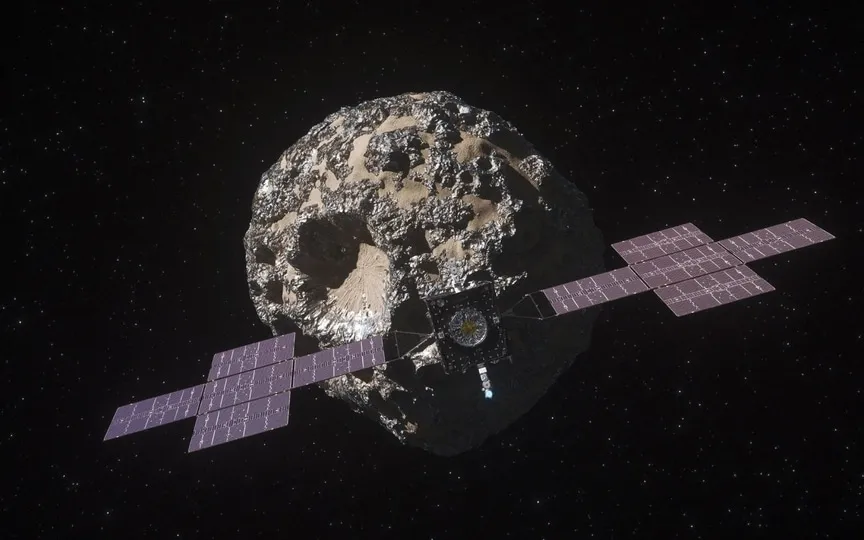Five Facts about NASA’s Journey to an Asteroid Made of Metal
NASA is embarking on an unprecedented mission as they send a probe to explore the asteroid Psyche, which is unique in its composition of metal rather than the typical rock, ice, or gas.
By studying this space oddity, scientists hope to learn more about the inner cores of rocky planets like our own – or possibly a previously unknown class of cosmic body.
Here are some fun facts about the mission that started on Friday.
– 10 quadrillion dollars –
If Psyche could be mined, its iron, nickel, and gold deposits could be worth an eye-popping $10,000 quadrillion dollars (that’s $10,000,000,000,000,000,000), according to an estimate reported by Forbes magazine.
But Lindy Elkins-Tanton, the mission’s principal investigator who was responsible for this calculation, said it was nothing more than “a fun intellectual exercise with no truth”.
“We have zero technology as a species to return Psyche to Earth,” he said at a recent press conference. Even if the venture succeeded, it would flood the metal market and reduce its value to zero, he said.
We are now on WhatsApp. Click to join.
– Electric trip –
The Psyche probe has blasted off on a SpaceX Falcon Heavy rocket, but to complete its 2.2-billion-mile (3.6 billion-kilometer) journey, it will switch to much more powerful propulsion.
Psyche’s solar panels convert light into electricity and provide power to its four solar-electric or “Hall-effect” thrusters. They use electromagnetic fields to accelerate and expel xenon ions (charged atoms), the same inert gas used in car headlights and plasma televisions.
Although the resulting blue glow is reminiscent of Star Trek, it’s not a warp force: the actual force it exerts at any given moment is roughly the weight of an AA battery in the palm of your hand.
But in the vacuum of space, the probe constantly accelerates to tens of thousands of kilometers per hour.
– Laser communication –
As deep space missions require ever-higher data transfer rates, NASA is moving to laser-based systems to complement radio-frequency-based communications.
Psyche is involved in a technology experiment to demonstrate “a 10-fold increase in data rates for traditional telecommunications,” said Abi Biswas of NASA’s Jet Propulsion Laboratory, which will allow higher-resolution images, more scientific data and video streaming to be sent.
NASA fires its laser beam from the JPL facility on Table Mountain, California, and the spacecraft fires its signal back to Caltech’s Palomar Observatory. The hope is to eventually use the technology in human missions to Mars.
– Gravitational Science –
Psyche has a set of special scientific instruments to study the asteroid’s chemical and mineral composition and look for signs of an ancient magnetic field.
But the science team is also using Psyche’s trusty old radio system to study the asteroid’s gravitational field using the Doppler effect.
“We can look at the pitch or frequency of the radio waves coming from the antenna and figure out how fast the spacecraft is moving” as it orbits the target, said planetary scientist Ben Weiss, just as ambulance sirens have a higher volume when they come. towards you and count as they move away.
By tracking the speed of the spacecraft at various points around the asteroid, they can determine how “lumpy” the gravitational field is, which in turn provides clues about the composition and structure of the interior.
– Less metal, more rock? –
Given its brightness, until recently it was widely agreed that Psyche was almost entirely metal—theorized to be the bare core of a planet whose rocky crust and mantle were blown away in an ancient collision.
But the way it exerts its gravitational pull on neighboring bodies suggests it’s less dense than an all-iron body should be, according to a 2022 study by researchers at Brown University.
One possibility they posit is iron-spewing volcanoes that lifted metal from Psyche’s core to coat its surface above the rocky mantle — effectively creating a structure resembling a metal sandwich.
Only in 2029, when the Psyche spacecraft reaches its destination, will we know for sure.
One more thing! ReturnByte is now on WhatsApp channels! Follow us by clicking on the link so that you never miss any updates from the world of technology. Click here to join now!




